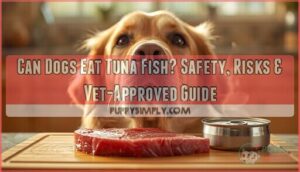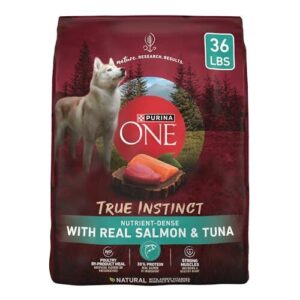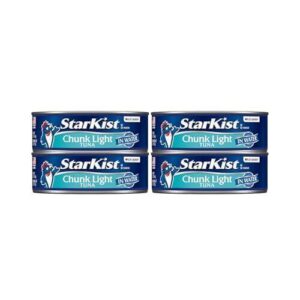This site is supported by our readers. We may earn a commission, at no cost to you, if you purchase through links.
Your dog’s pleading eyes make it hard to resist sharing your tuna sandwich, but that moment of generosity could carry unexpected consequences. Tuna sits in a gray zone for canine nutrition—it’s not toxic like chocolate or grapes, yet it’s far from an ideal food choice.
The fish packs valuable omega-3 fatty acids and protein, but it also concentrates mercury and sodium that can harm your dog over time. Small portions of the right kind of tuna won’t hurt your pet, but regular servings can lead to serious health problems that many dog owners don’t anticipate until symptoms appear. The answer to whether dogs can eat tuna fish depends entirely on how much, how often, and which type you offer.
Table Of Contents
- Key Takeaways
- Can Dogs Eat Tuna Fish Safely?
- Nutritional Benefits of Tuna for Dogs
- Health Risks of Feeding Tuna to Dogs
- Mercury Poisoning in Dogs
- Safe Tuna Options for Dogs
- Can Dogs Eat Raw or Canned Tuna?
- Special Considerations for Puppies and Sensitive Dogs
- Healthy Fish Alternatives to Tuna
- Top 3 Tuna Products for Dogs
- Frequently Asked Questions (FAQs)
- Can dogs eat tuna?
- How to safely feed canned tuna to dogs?
- How long can a dog eat tuna?
- What happens if a dog eats tuna?
- How much canned tuna can I give my dog?
- Is tuna fish ok for dogs?
- Can dogs eat scrambled eggs?
- What canned fish can dogs eat?
- How do I prepare canned tuna for my dog?
- Can dogs eat canned tuna?
- Conclusion
Key Takeaways
- Dogs can eat tuna in small amounts as an occasional treat, but it should never become a regular part of their diet due to mercury accumulation and high sodium levels that can cause serious health problems over time.
- Choose light tuna packed in water with no added salt, drain and rinse it thoroughly, and limit portions based on your dog’s size—small dogs get 1-2 teaspoons weekly while large dogs can handle up to one 5-ounce can spread across the week.
- Mercury poisoning from excessive tuna consumption causes neurological symptoms like tremors, blindness, and loss of coordination, along with kidney damage and gastrointestinal issues that require immediate veterinary attention.
- Safer fish alternatives like salmon, sardines, and herring provide the same omega-3 benefits and protein without tuna’s high mercury content, making them better choices for regular feeding.
Can Dogs Eat Tuna Fish Safely?
Yes, dogs can eat tuna fish, but it’s not a simple green light. The answer depends on how much you feed, how often, and whether your dog has special health needs.
Let’s break down what veterinarians recommend to keep your pup safe and healthy.
Occasional Treat Vs. Regular Diet
Tuna should never become a regular fixture in your dog’s diet. Think of it as a special occasion treat rather than a dinner staple. Here’s the key distinction:
- Occasional treat: Once or twice weekly reduces mercury exposure and sodium concerns
- Regular diet: Daily feeding increases risk evaluation for toxicity and nutritional imbalance
- Safe approach: Canned tuna for dogs works best as a rare topper, not a meal replacement
Excessive tuna consumption can lead to mercury poisoning.
Recommended Serving Sizes
Your dog’s size determines how much tuna is safe. Small dogs under 20 pounds can have 1–2 teaspoons weekly, while medium breeds (21–50 pounds) should get no more than 1–2 tablespoons. Large dogs over 50 pounds can handle up to one 5-ounce can spread across the week.
A weight-based approach works best: roughly 1 tablespoon per 20 pounds of body weight keeps moderation in check. It’s vital to think about tuna’s mercury levels for your dog’s safety.
Veterinary Guidance on Tuna
Beyond portion size, expert opinion matters just as much. Veterinarians consistently warn that tuna frequency should never be daily. The American Kennel Club and PetMD both advise limiting tuna to a rare treat because of mercury risks.
Safe tuna use means choosing light tuna in water and watching for these signs your vet wants you to know:
- Tremors or coordination problems
- Vomiting or kidney issues
- Vision changes or hair loss
Alternative fish like salmon offer better canine nutrition without the worry.
Nutritional Benefits of Tuna for Dogs
Tuna does offer some real nutritional value for your dog when served in the right amounts. The omega-3s and protein can support your pet’s health in meaningful ways.
Let’s look at the specific benefits tuna brings to the table.
Omega-3 Fatty Acids and Joint Health
When your dog moves like their joints have rusted overnight, omega-3 fatty acids from tuna might help turn back the clock. These omega-3 fatty acids work by reducing inflammatory mediators that damage cartilage and limit mobility. Clinical trials show dogs receiving 70 mg of EPA and DHA per kilogram daily experienced a 50% reduction in joint pain within six weeks.
Omega-3 fatty acids from tuna can reduce joint pain in dogs by 50% within six weeks by fighting cartilage inflammation
| Benefit | Research Finding |
|---|---|
| Mobility Improvements | 33% better movement scores in arthritic dogs |
| Cartilage Effects | Reduced inflammation protects joint tissues |
| Long-Term Safety | 24-week studies showed no major side effects |
Dosage recommendations for arthritis generally range from 75–100 mg combined EPA and DHA per kilogram of your dog’s body weight. This nutritional benefit of tuna makes fish for dogs a therapeutic option, though veterinary supervision ensures proper long-term safety for dog health.
Protein and Essential Nutrients
Muscle maintenance demands high-quality building blocks, and tuna delivers concentrated lean protein with a superb amino acid profile. A 100-gram serving provides 24–29 grams of protein, supporting your dog’s tissue repair and immune function through essential nutrients for dogs.
- Taurine benefits cardiac and retinal health, with bluefin offering 382 milligrams per 4-ounce serving
- Vitamin B12 density reaches 125% of human daily value, energizing nervous system function
- Mineral content includes 80 micrograms selenium and 163 milligrams phosphorus per 100 grams
Effects on Skin and Coat
When your dog receives EPA and DHA from tuna, those Omega-3 fatty acids help restore healthy skin barrier function and deliver a shiny coat by reducing inflammation and transepidermal water loss.
However, tuna allergens can trigger rash and itching in sensitive dogs, while mercury effects and histamine reactions from spoiled fish may worsen coat quality rather than improve it.
Health Risks of Feeding Tuna to Dogs
While tuna offers nutritional benefits, it comes with serious risks you need to understand before sharing it with your dog. The dangers aren’t always obvious, but they can affect your pet’s health in significant ways.
Let’s look at the three main concerns that make tuna a risky choice for regular feeding.
Mercury Content and Toxicity
When choosing tuna for your dog, mercury content becomes your biggest concern. This heavy metal accumulates in fish tissues over time and can cause serious toxicity symptoms in dogs.
- Mercury bioaccumulation: Larger tuna species like albacore contain higher mercury levels (0.774 ppm) than light tuna (0.358 ppm)
- Toxicity symptoms: Watch for tremors, hair loss, blindness, and loss of coordination
- Tuna species matter: Bigeye and sushi-grade tuna show the highest mercury content
- Regional variations: Pacific tuna mercury levels vary fivefold by location
- Safe limits: Veterinarians recommend minimal portions to prevent mercury poisoning
High Sodium Levels
Salt content in canned tuna poses a hidden threat to your dog’s health. Tuna in brine contains about 368 mg of sodium per 100 g—nearly double the spring water version at 197 mg. This excess sodium can trigger vomiting, diarrhea, and increased thirst.
Dogs with heart disease or kidney issues face even greater risks from sodium toxicity, making dietary restrictions essential when feeding any tuna.
Choking Hazards From Bones
Fish bones turn a simple meal into a medical emergency. Even small fragments can lodge in your dog’s throat or tear delicate tissue as they pass through the digestive tract.
Research reveals the serious nature of bone-related incidents:
- Esophageal obstruction affected 35% of dogs with upper gastrointestinal bone foreign bodies in clinical studies
- Bone fragment damage caused mucosal erosions in 62% of esophageal cases
- Bone treat risks resulted in approximately 90 reported illnesses and 15 deaths between 2010 and 2017
- Regulatory data confirms that commercially sold bone products require emergency veterinary visits for blockages and choking
Always choose boneless tuna canned in water as safe food for dogs.
Mercury Poisoning in Dogs
Mercury poisoning is one of the most serious risks when dogs eat tuna regularly. The heavy metal builds up in your dog’s body over time and can affect multiple organ systems.
Understanding how mercury accumulates, what symptoms to watch for, and how to prevent toxicity will help you keep your dog safe.
How Mercury Accumulates in Tuna
Mercury enters oceans from coal combustion and industrial activities, then bacteria in low-oxygen zones convert it to methylmercury. This toxic form moves up the food web—from tiny plankton to small fish to tuna.
Because tuna can’t excrete methylmercury well, it builds up in their muscle tissue over time. Larger, older tuna accumulate more mercury than smaller species like skipjack, creating geographic variations in mercury content across different ocean regions.
Symptoms of Mercury Poisoning
When mercury poisoning in dogs develops, you’ll notice distinct warning signs. Neurological signs like tremors, blindness, and loss of coordination often appear first. Your dog may also show gastrointestinal issues—vomiting blood, diarrhea, or abdominal pain.
Behavioral changes such as anxiety or lethargy are common. Renal effects include kidney damage and inability to urinate, while cardiovascular impact can cause weakness and collapse in severe cases.
Diagnosis and Prevention
If you suspect mercury poisoning in dogs, your veterinarian will run mercury testing on blood and urine samples to confirm exposure. Elevated levels above 3 µg/L signal a problem. Treatment may include chelation therapy with medications like dimercaprol to bind the toxin, plus IV fluids to protect against renal damage.
Prevention starts with dietary strategies:
- Limit tuna to rare treats—once weekly at most keeps mercury low
- Choose safe fish alternatives for dogs like sardines or salmon instead
- Serve safe portions—a teaspoon for small dogs, a tablespoon for large breeds
- Skip tuna entirely for puppies, pregnant dogs, or those with kidney issues
- Monitor symptoms of mercury poisoning after any fish meal to catch dog health concerns early
Safe Tuna Options for Dogs
If you decide to offer tuna to your dog, choosing the right type makes all the difference. Not all canned tuna is created equal, and some varieties pose greater risks than others.
Here’s what you need to know about selecting safe tuna options and feeding them responsibly.
Canned Tuna in Water Vs. Oil
When choosing canned tuna for your dog, always pick the water-packed variety over oil. Oil-packed tuna contains more than double the calories and considerably higher fat content, which raises pancreatitis risk in dogs.
Although mercury exposure remains similar in both forms, water-packed tuna offers safer feeding with lower sodium levels and reduced digestive upset—making it the smart choice for occasional dog food treats.
Avoiding Tuna With Added Salt or Bones
Selecting the right product matters just as much as the type. Always read labels carefully and choose tuna marked “no salt added” or “low sodium”—standard varieties can pack 350–600 mg of sodium per can, which strains your dog’s heart and kidneys.
Before serving, rinse the tuna and inspect each flake by hand for bones that could lodge in your dog’s throat or tear digestive tissue.
Portion Control and Frequency
Moderation is the foundation of safe tuna feeding, because even low-mercury fish becomes risky when fed too often. Weekly tuna limits depend on your dog’s size and help reduce mercury exposure limits that can harm the nervous system over months.
Follow these body-weight-based portion guidelines to keep treat calorie impact under 10% of your dog’s daily intake:
- Small dogs (up to 20 lb): 1–2 teaspoons once per week
- Medium dogs (21–50 lb): 1–2 tablespoons once per week
- Large dogs (over 50 lb): 2–3 tablespoons once per week
Your veterinarian can adjust these limits for puppies, pregnant dogs, or animals with kidney disease, tailoring feeding tuna to dogs around individual health needs and ensuring dog nutrition and diet remain balanced.
Can Dogs Eat Raw or Canned Tuna?
You might wonder whether it’s safer to give your dog raw tuna or stick with the canned stuff from your pantry. The truth is that both options come with their own set of risks that you need to understand before serving.
Let’s break down the dangers of raw tuna, how to prepare it safely, and which type works best for your dog.
Dangers of Raw Tuna
Raw tuna poses serious risks of feeding tuna to dogs that cooked versions don’t. It often carries parasite contamination and bacterial risks that can cause food poisoning and digestive upset.
Raw fish also contains thiaminase, an enzyme that depletes vitamin B1, potentially leading to neurological damage.
Combined with mercury exposure, regulatory warnings strongly advise against raw tuna for your dog’s safety.
Safe Preparation Methods
You’ll want to thoroughly cook fresh tuna by steaming, grilling, or baking—never frying. Remove all bones, fins, and heads before serving to prevent choking.
If using canned tuna, choose “light” varieties packed in water with no added salt. Drain and rinse it to cut sodium levels. Skip the seasonings, sauces, and added fats that can upset your dog’s stomach.
Choosing The Right Type of Tuna
Not all tuna is created equal when it comes to tuna safety for your dog. Mercury levels vary dramatically by tuna species and how it’s packed.
- Choose skipjack tuna (labeled “chunk light”) over albacore tuna—it contains about 0.126 ppm mercury versus 0.358 ppm in white albacore
- Select water-packed products to avoid unnecessary calories and fat from oil
- Check labels for “no salt added” to minimize sodium content and skip varieties with added ingredients like garlic or onion
Special Considerations for Puppies and Sensitive Dogs
Not all dogs can handle tuna the same way. Puppies, small breeds, pregnant dogs, and those with existing health problems face greater risks from mercury and sodium.
Let’s look at the specific groups that need extra protection regarding tuna.
Risks for Puppies and Small Breeds
Puppies face heightened health risks from tuna because their developing organs struggle to process mercury. Small breeds are especially vulnerable—a tiny portion translates to massive exposure per pound of body weight.
Mercury accumulation can disrupt neurological development during critical growth phases. Sodium sensitivity compounds these dangers, making portion control essential.
Safer alternatives like salmon offer similar omega-3 benefits without the risks of feeding tuna to dogs. Consider puppy dietary considerations carefully before offering any fish.
Pregnant and Lactating Dogs
Pregnancy changes everything regarding your dog’s diet. Mercury transfer across the placenta threatens developing puppies’ nervous systems, making tuna unsafe during gestation and lactation.
While omega-3 benefits matter, safe alternatives like formulated fish oils deliver what your dog needs without the toxin load. Stick to purpose-built diets that meet pet nutrition standards for these critical life stages.
Dogs With Preexisting Health Conditions
Kidney disease, heart disease, diabetes, pancreatitis, and neurological disorders turn tuna from questionable to dangerous. Renal disease patients need low-sodium diets—not tuna’s salt load. Cardiac concerns worsen with fluid retention. Pancreatitis risks spike from fat content. Allergies and sensitivities trigger vomiting or itching. Mercury’s neurological impact compounds existing seizure disorders.
Your vet knows your dog’s vulnerabilities—therapeutic diets beat guesswork every time.
Healthy Fish Alternatives to Tuna
If tuna feels too risky for your dog’s regular diet, you’re not alone in looking for safer options. Several fish varieties offer similar nutritional benefits without the high mercury levels that make tuna concerning.
Let’s look at some fish alternatives that can give your dog the omega-3s and protein they need with fewer worries.
Salmon and Sardines
Salmon and sardines offer safer fish choices for your dog than tuna. Both deliver omega-3 benefits without the high mercury levels found in tuna.
Sardines pack roughly 1,600–1,800 mg of omega-3s per serving, while salmon provides excellent protein and essential nutrients. Choose canned versions in water with no added salt.
Feeding guidelines suggest offering these fish three to seven times weekly as a healthy topper.
Low-Mercury Fish Options
Beyond salmon and sardines, you have other safe fish options for dogs. Small whitefish like herring and Atlantic mackerel contain mercury levels below 0.15 micrograms per gram, making them excellent freshwater options for canine diets.
Canned light fish products generally stay under 0.23 micrograms per gram—much safer than large predatory species. Adjust portion frequency based on mercury content: fish with lower levels can be offered more often while keeping your dog healthy.
Fish-Based Dog Foods
If fresh fish isn’t practical, quality fish-based dog food offers consistent omega-3 benefits and digestibility factors without mercury concerns. Commercial formulas use low-mercury protein sources like salmon and whitefish, meeting life-stage diets requirements while addressing allergy concerns that chicken or beef trigger.
Look for dog food ingredients that include:
- Marine proteins as the first listed component for complete canine diet nutrition
- Fortified omega-3 fatty acids supporting joint and skin health throughout your dog’s life
- Hypoallergenic seafood formulations designed specifically for sensitive stomachs and food trials
Top 3 Tuna Products for Dogs
If you decide to offer your dog tuna, choosing the right product makes all the difference for safety and nutrition. Some options are specifically formulated for dogs, while others are human-grade products that work well in small amounts.
Here are three vet-approved tuna products that balance quality with convenience.
1. Purina ONE Salmon and Tuna Food
If you’re looking for a complete dog food with tuna, Purina ONE True Instinct with Real Salmon and Tuna offers a balanced option. This formula lists real salmon as the number one ingredient, with added tuna for extra protein.
The nutritional benefits include 30% crude protein to support muscle health, natural glucosamine from fish for joints, and omega-6 fatty acids for skin and coat.
Feeding guidelines recommend portions based on your dog’s weight, and product variations include 7.4 lb and 15 lb bags. Customer reviews are mixed regarding quality consistency, so monitor your dog carefully when introducing this food.
Best For: Dog owners seeking a high-protein, fish-based formula with joint support for active adult dogs who tolerate salmon and tuna well.
- Real salmon is the first ingredient with 30% protein to build strong muscles and support heart health
- Includes natural glucosamine from fish for joint health plus omega fatty acids for skin and coat
- No artificial flavors or preservatives, with every ingredient serving a nutritional purpose
- Some customers report quality control issues including inconsistent smell and occasional mold
- Mixed results for dogs with allergies—not all sensitive dogs tolerate the formula well
- Reactions vary widely, so careful monitoring is needed when switching to this food
2. Chef Kitty Freeze Dried Tuna Treats
For a high-protein dog treat option, Chef Kitty Freeze Dried Tuna Treats provide 100% wild-caught tuna with no additives. The treat nutritional profile shows about 80% crude protein, making it energy-dense at roughly 3,600 kilocalories per kilogram. However, mercury exposure risks remain a concern since freeze-drying doesn’t remove heavy metals.
Feeding guidelines suggest using these as occasional toppers or rewards—not exceeding 10% of your dog’s daily calories. Regulatory compliance ensures proper labeling, but remember that canned tuna and tuna dog treats should always complement, never replace, balanced dog food for best dog health and diet.
Best For: Dog owners looking for a single-ingredient, high-protein training reward or meal topper to use occasionally, especially for pets with food sensitivities.
- 100% wild-caught tuna with no fillers, additives, or preservatives—just pure protein at around 80%
- Freeze-dried process locks in nutrients and natural flavor without heat damage
- Works dry as a crunchy treat, rehydrated for softer texture, or crumbled as a topper
- Tuna’s high mercury content means you need to limit how often you give it—occasional use only
- Some customers report quality control issues with pieces being too hard or rock-solid
- Price runs steep at $26.95 for 3.5oz compared to other treat options
3. StarKist Chunk Light Tuna in Water
StarKist Chunk Light Tuna in Water offers a convenient option when you’re looking to add variety to your dog’s diet. Each 5-ounce can delivers 20 grams of protein with only 90 calories, but sodium content sits at 360 milligrams—high for smaller breeds. Mercury levels in light tuna average 0.118 ppm, lower than albacore varieties.
Safe handling requires refrigerating opened cans and using portions within 48 hours to prevent histamine risk. Limit serving sizes to a few tablespoons weekly for small dogs, ensuring tuna safety for dogs remains your priority.
Best For: Dog owners who want to add an occasional protein boost to their pet’s meals without exceeding mercury limits, especially if they have larger dogs that can handle moderate sodium intake.
- Low mercury content compared to albacore varieties (0.118 ppm average) makes it safer for regular but limited use
- High protein and low calorie profile (20g protein, 90 calories per can) works well as a meal topper without adding excessive calories
- Dolphin-safe and gluten-free certification gives peace of mind about sourcing and allergen concerns
- High sodium content (360mg per can) can be problematic for smaller dogs or those with heart conditions
- Requires strict portion control and refrigeration after opening to prevent histamine buildup within 24-48 hours
- Should only be fed occasionally (a few tablespoons weekly for small dogs, up to one can weekly for large dogs) due to cumulative mercury exposure risks
Frequently Asked Questions (FAQs)
Can dogs eat tuna?
Yes, dogs can eat tuna in small amounts as an occasional treat. Think of it like dessert—enjoyable but not meant for every meal.
Moderation prevents mercury buildup while providing omega-3 benefits for your dog’s health.
How to safely feed canned tuna to dogs?
Drain and rinse canned tuna packed in water to reduce sodium, then offer small portions once or twice weekly. Consult your vet before adding tuna to your dog’s diet.
How long can a dog eat tuna?
Tuna safety for dogs depends on limiting exposure. Veterinary advice recommends once or twice weekly for healthy adults, never as a daily staple.
Mercury accumulation increases with prolonged feeding, making portion control and safe frequency essential.
What happens if a dog eats tuna?
Most healthy dogs experience no acute toxicity from small amounts, though GI upset, sodium overload, or digestive issues like vomiting and diarrhea may occur.
Repeated feeding increases mercury burden and poisoning risk.
How much canned tuna can I give my dog?
Your dog’s serving depends on breed size and body weight. Small dogs under 10 kilograms should get about one teaspoon weekly, while large dogs can have up to one tablespoon per serving.
Is tuna fish ok for dogs?
Yes, dogs can eat tuna in small amounts occasionally. However, you should limit portions due to mercury levels and avoid making it a regular part of your dog’s diet.
Can dogs eat scrambled eggs?
Regarding scrambled eggs, preparation methods matter most for dog food safety. Plain eggs offer nutritional benefits and protein, but avoid butter, salt, and onions.
Monitor for egg allergies, especially in special populations like puppies.
What canned fish can dogs eat?
Canned sardines, salmon, mackerel, and anchovies packed in water offer your dog safe fish options with lower mercury levels.
Choose plain, no-salt varieties and rinse before serving to reduce sodium content by about 80%.
How do I prepare canned tuna for my dog?
Start by choosing unsalted canned tuna in water, then drain and rinse it thoroughly to reduce sodium content. Remove any bones carefully, shred into small pieces, and serve at room temperature to support dog digestive health.
Can dogs eat canned tuna?
Dogs can eat canned tuna as an occasional treat in small amounts. Choose light tuna packed in water, drain it well, and limit servings to once or twice weekly to minimize mercury exposure.
Conclusion
Feeding fish to Fluffy requires thoughtful planning and portion control. While dogs can eat tuna fish in small amounts, it shouldn’t become a staple in their diet. Choose low-sodium options packed in water, limit servings to occasional treats, and watch for any adverse reactions.
Your dog’s health depends on balanced nutrition, not convenient human food shares. When uncertainty strikes, your veterinarian remains your most reliable resource for individual feeding guidance.
- https://www.petmd.com/dog/nutrition/can-dogs-eat-tuna
- https://www.purina.com/articles/dog/feeding/can-dogs-eat/tuna
- https://wefeedraw.com/blog/can-dogs-eat-tuna
- https://www.petscare.com/news/faq/how-much-canned-tuna-can-i-give-my-dog
- https://todaysveterinarypractice.com/nutrition/fish-oil-dosing-in-pet-diets-and-supplements/




















